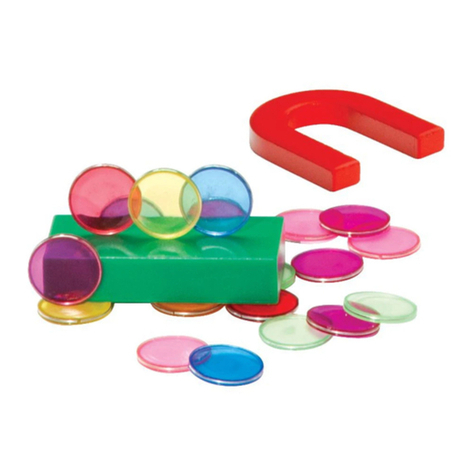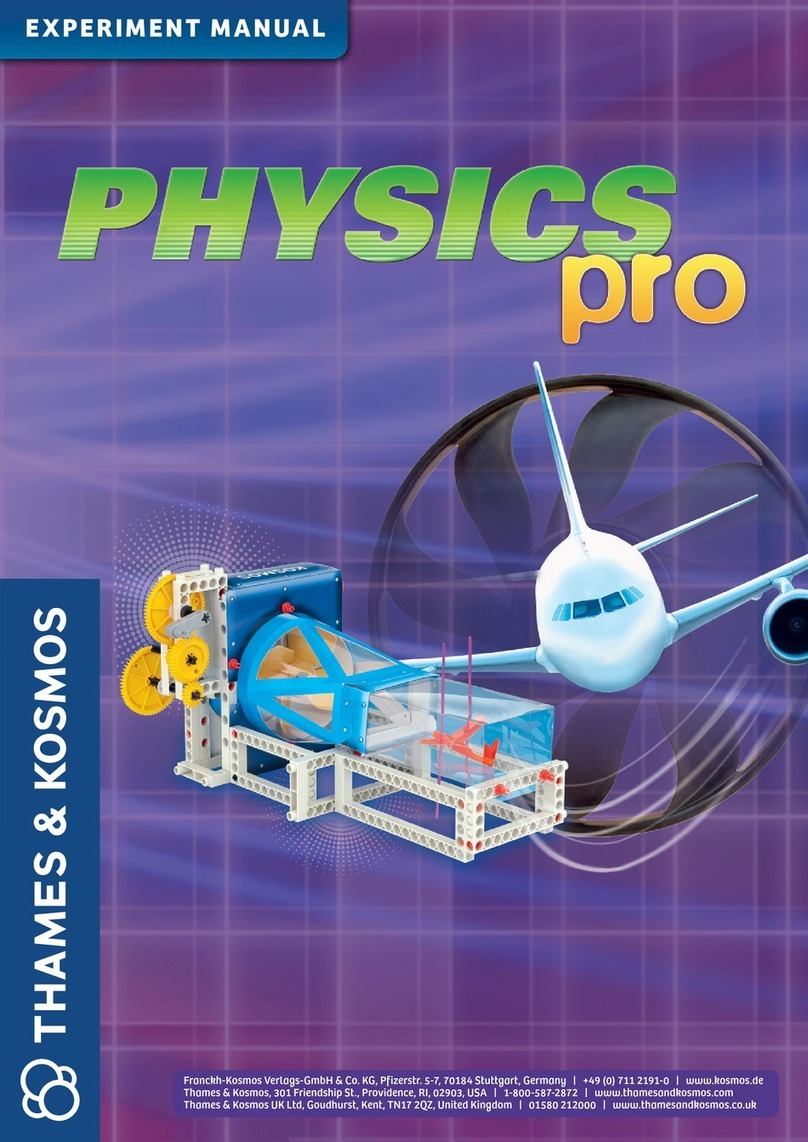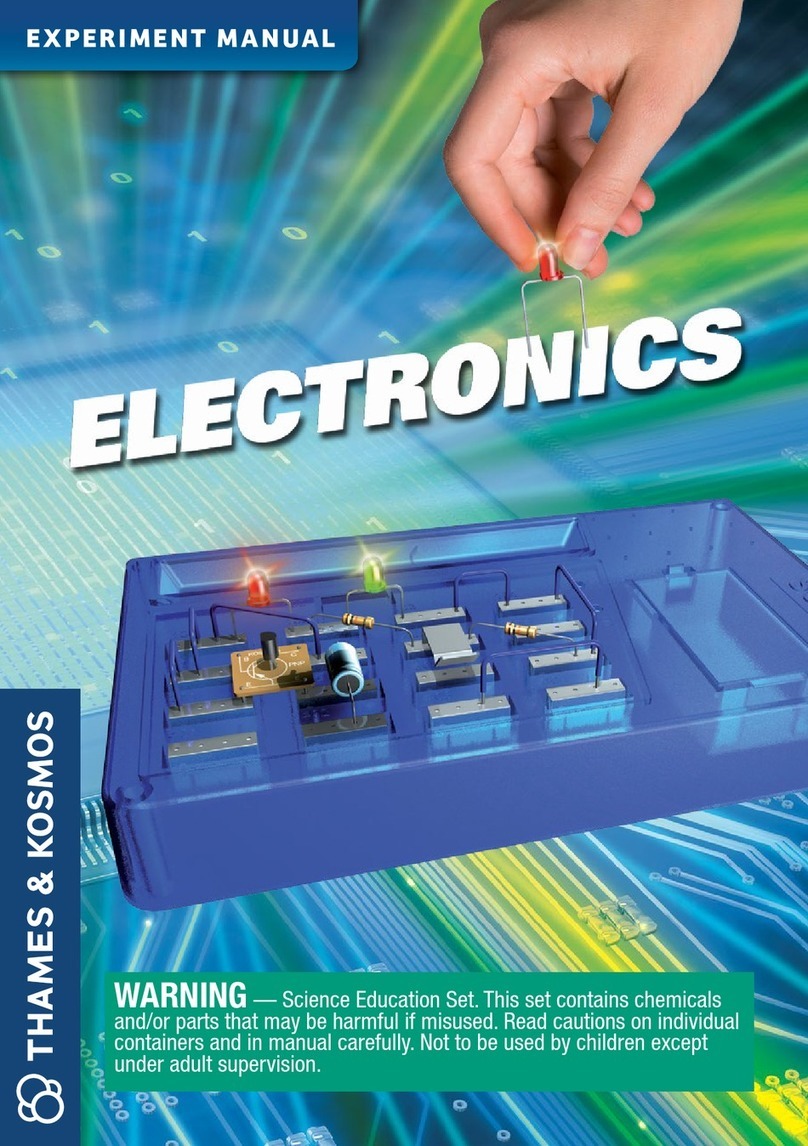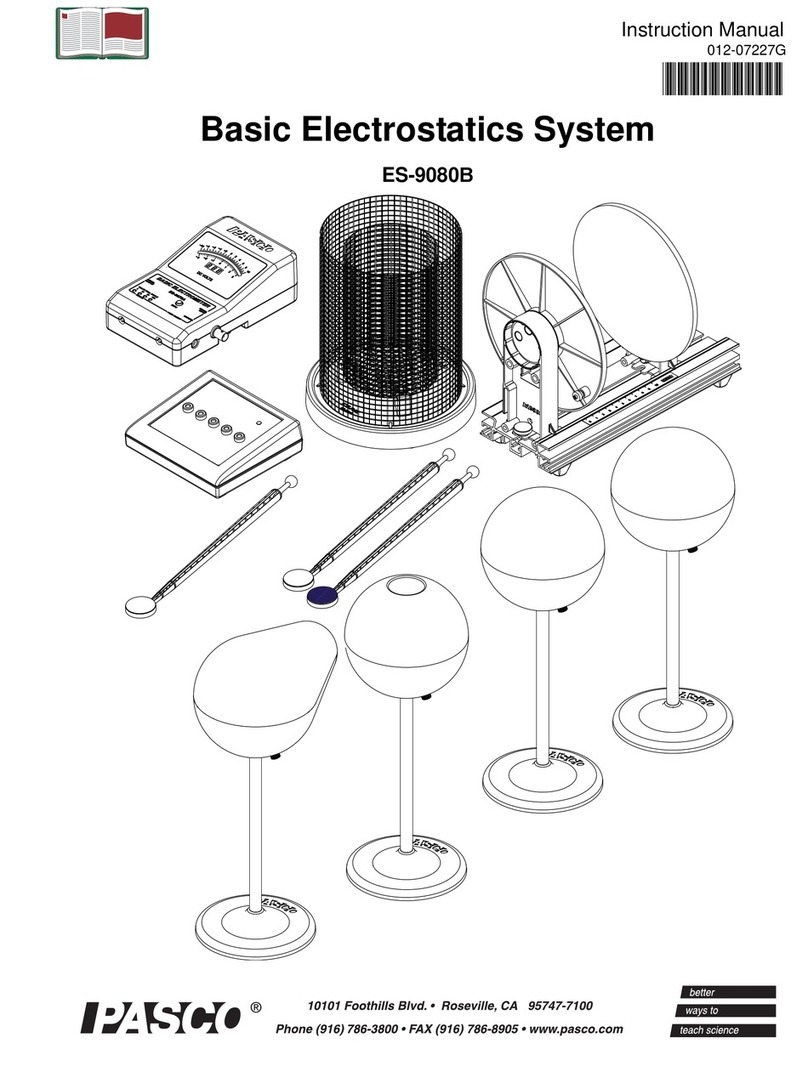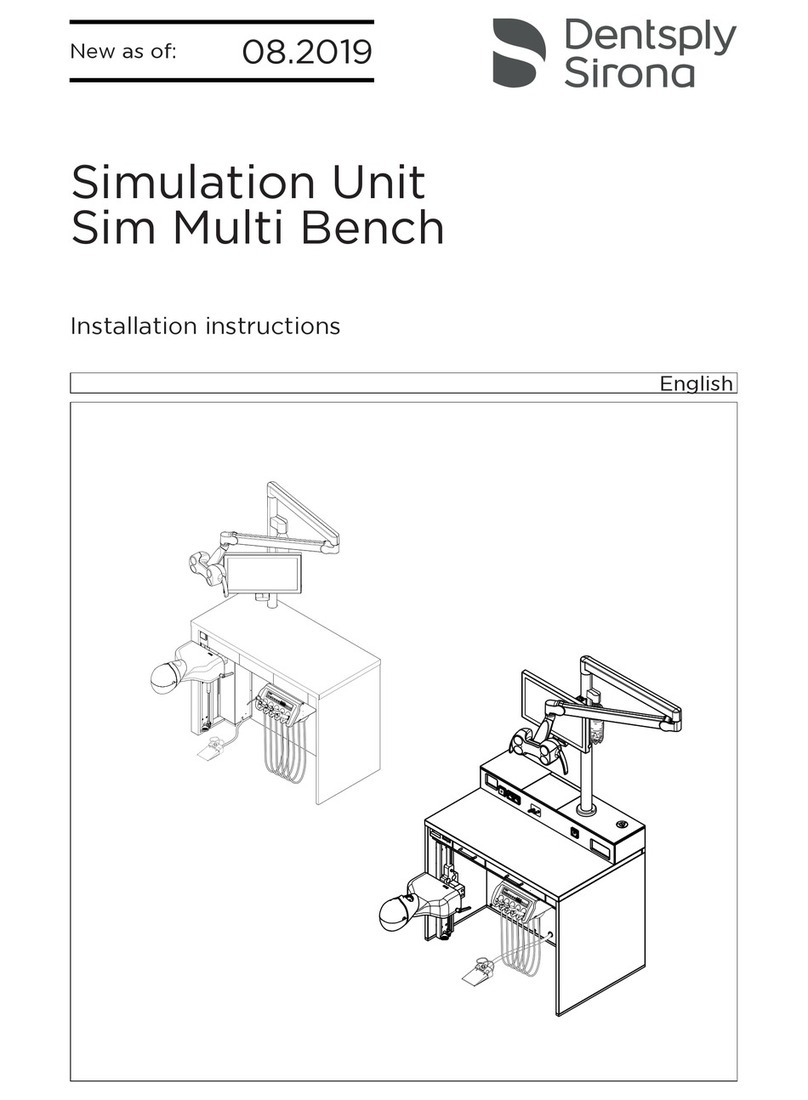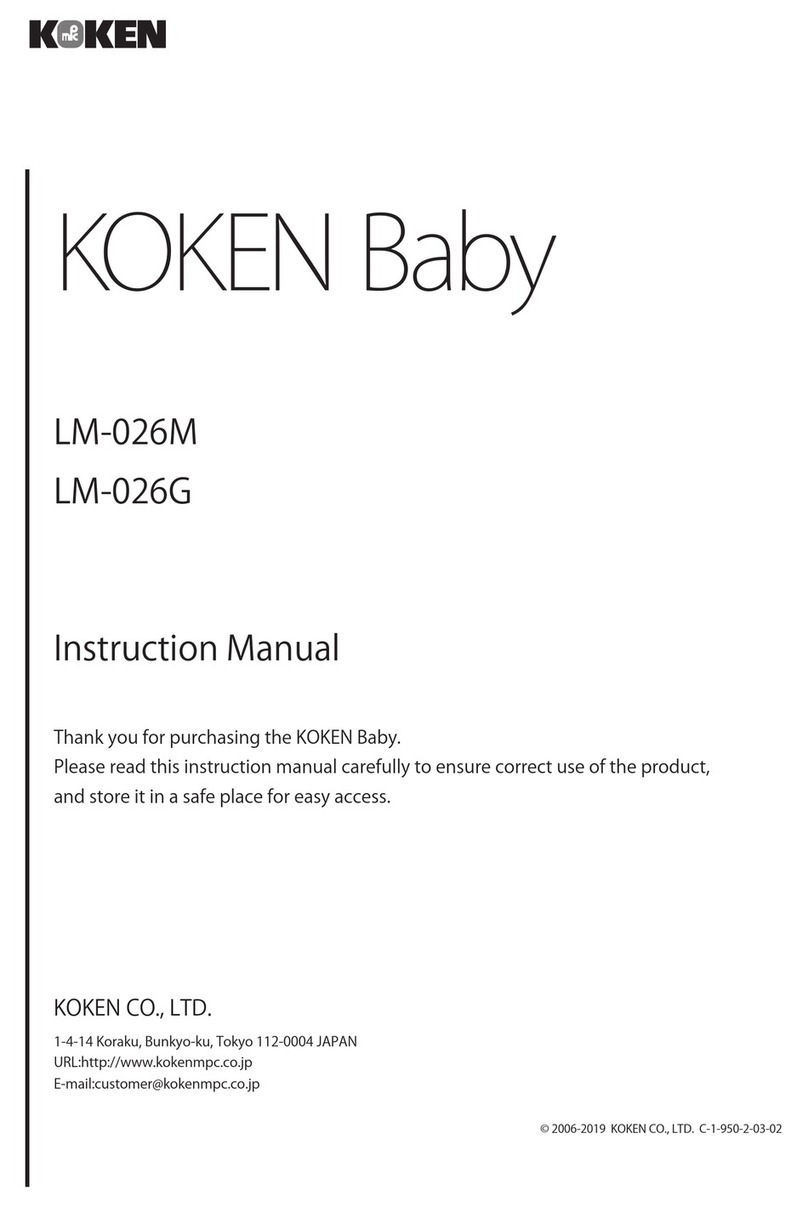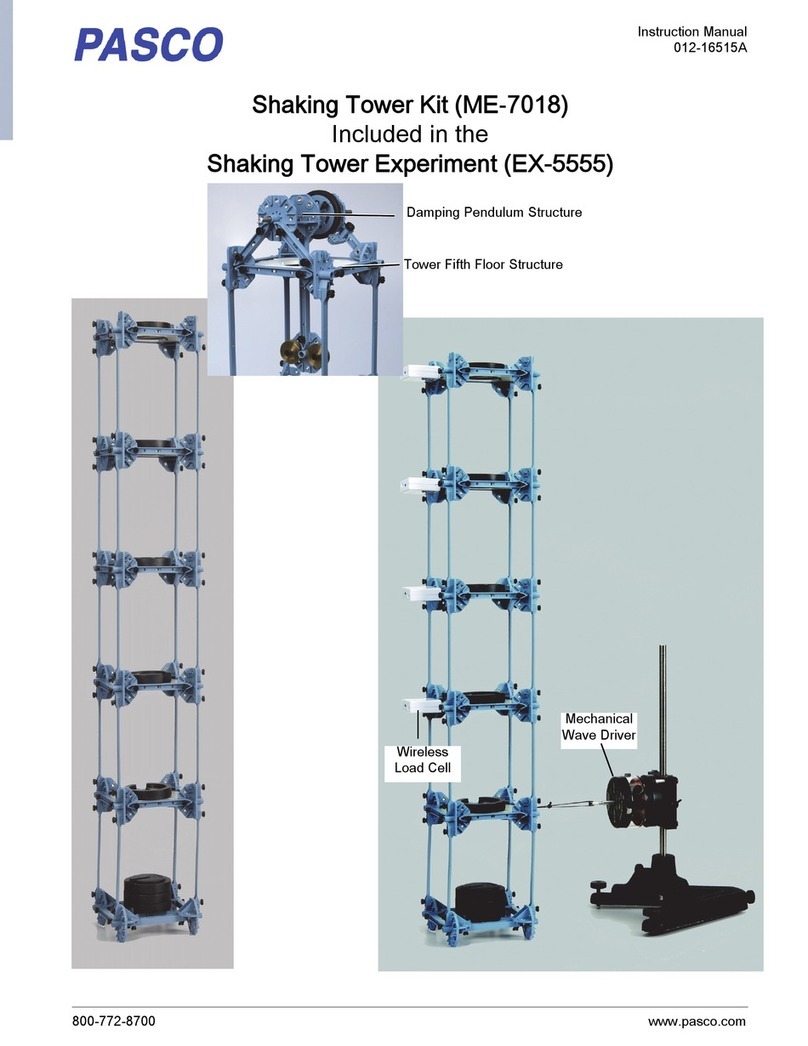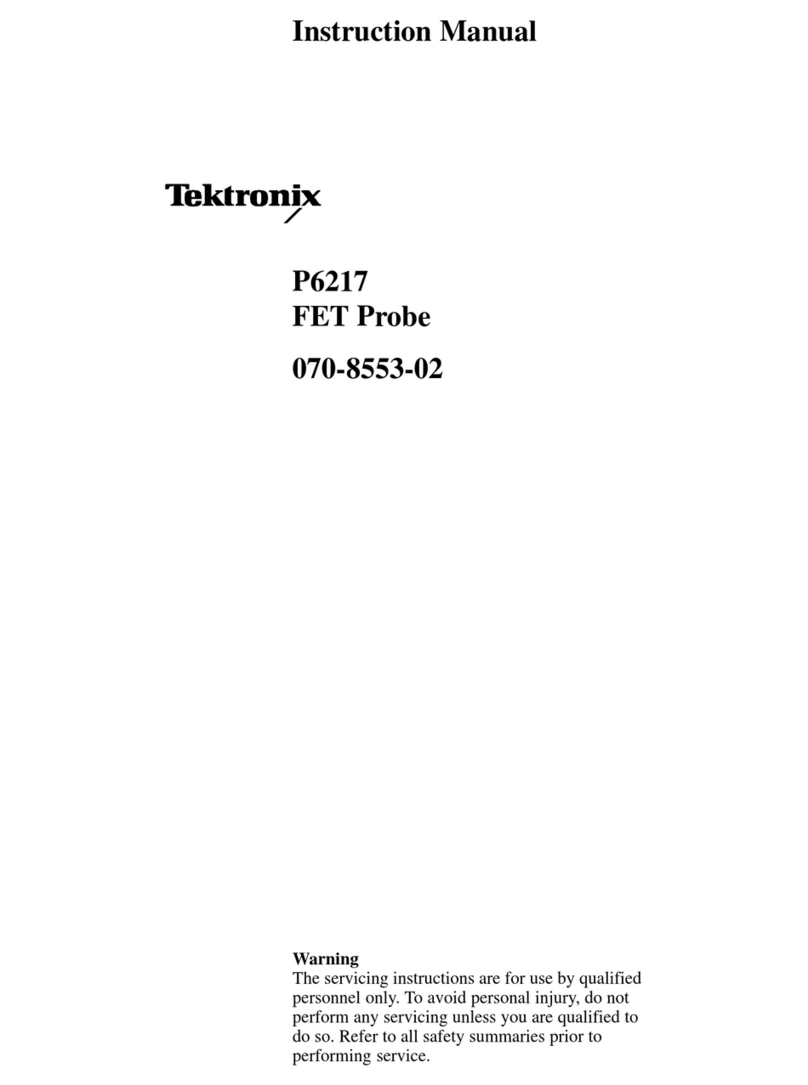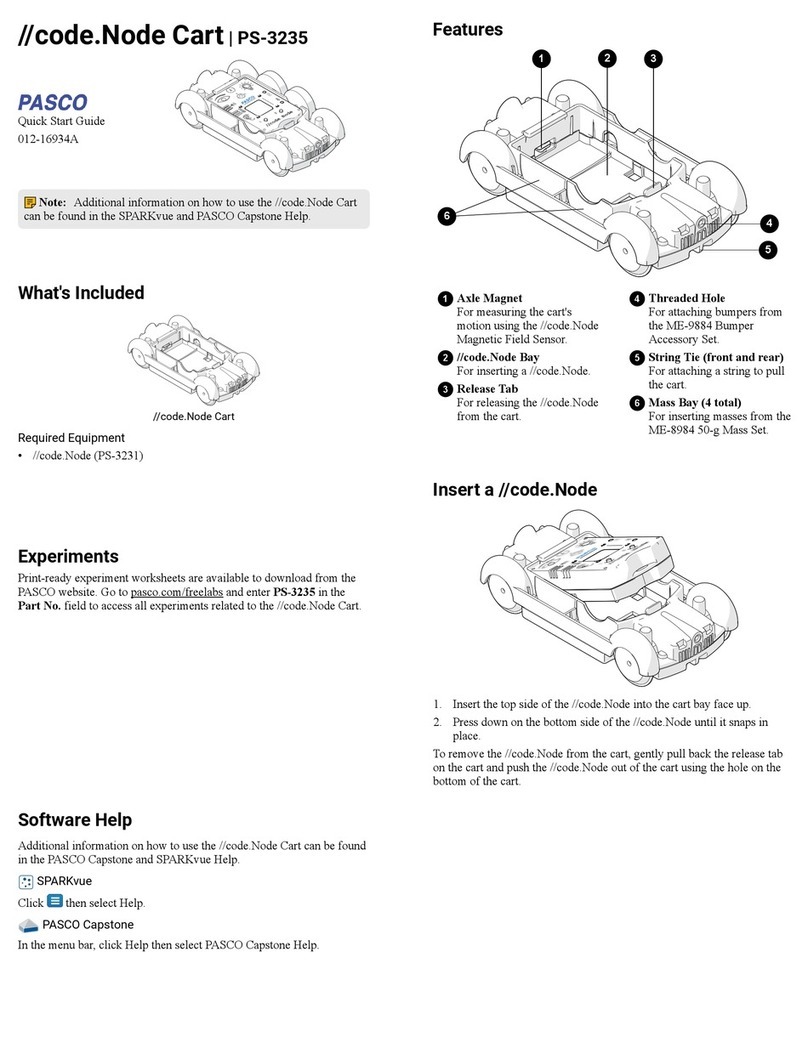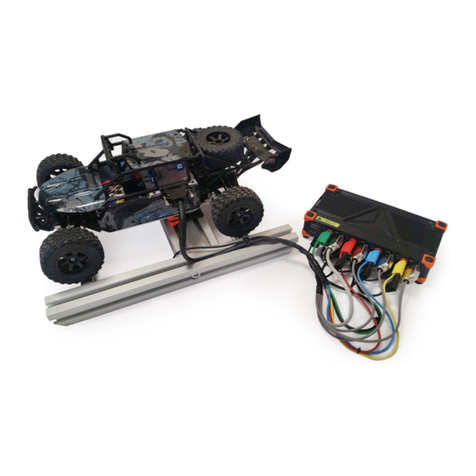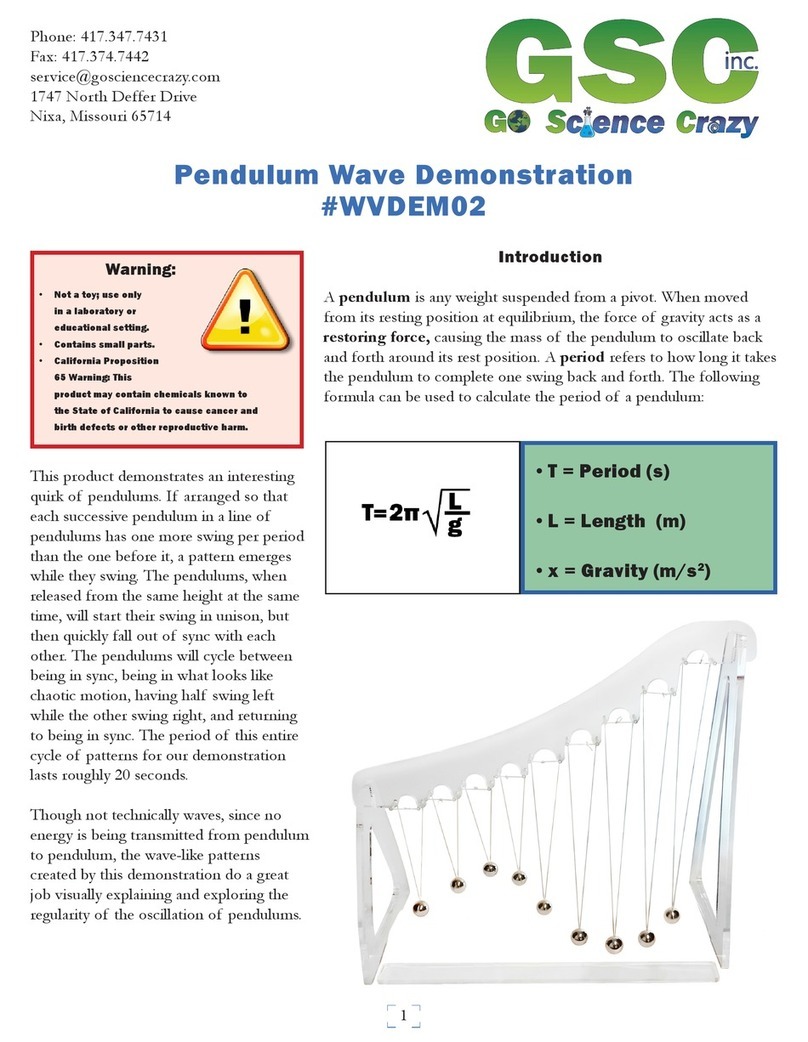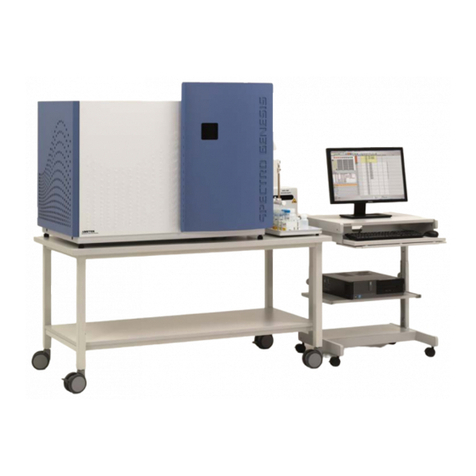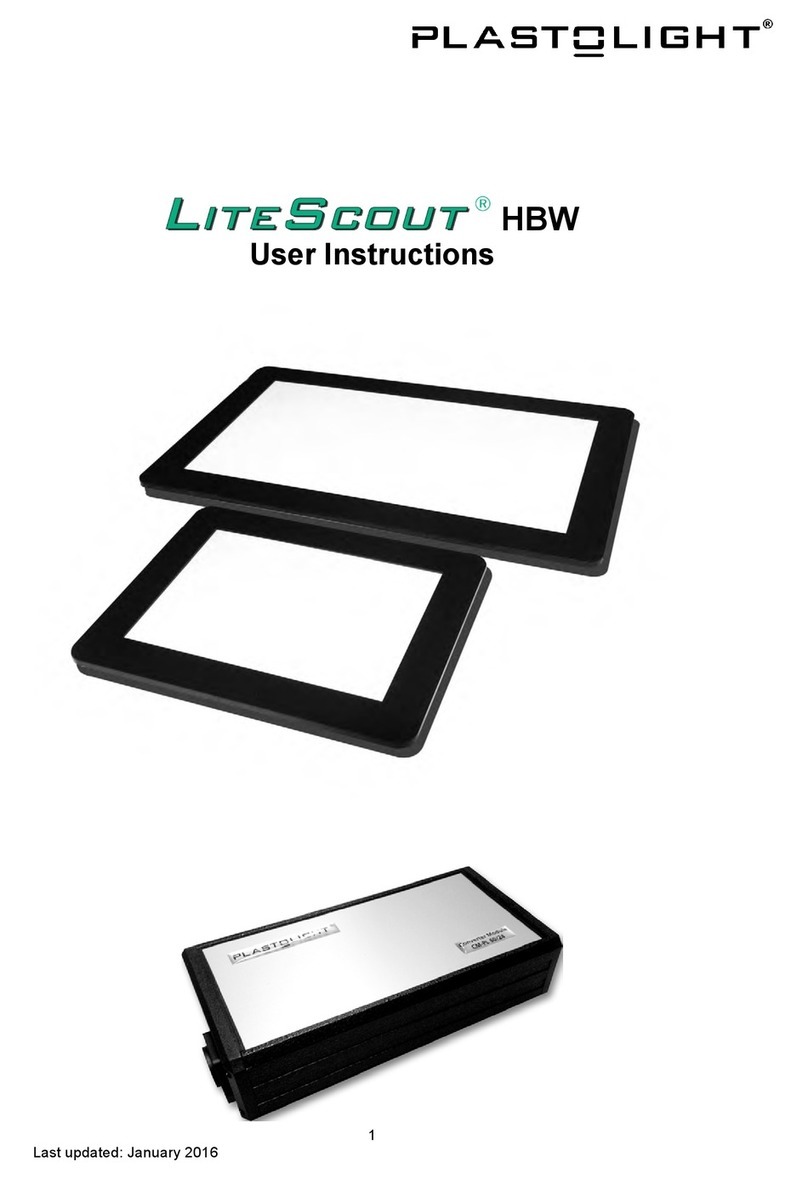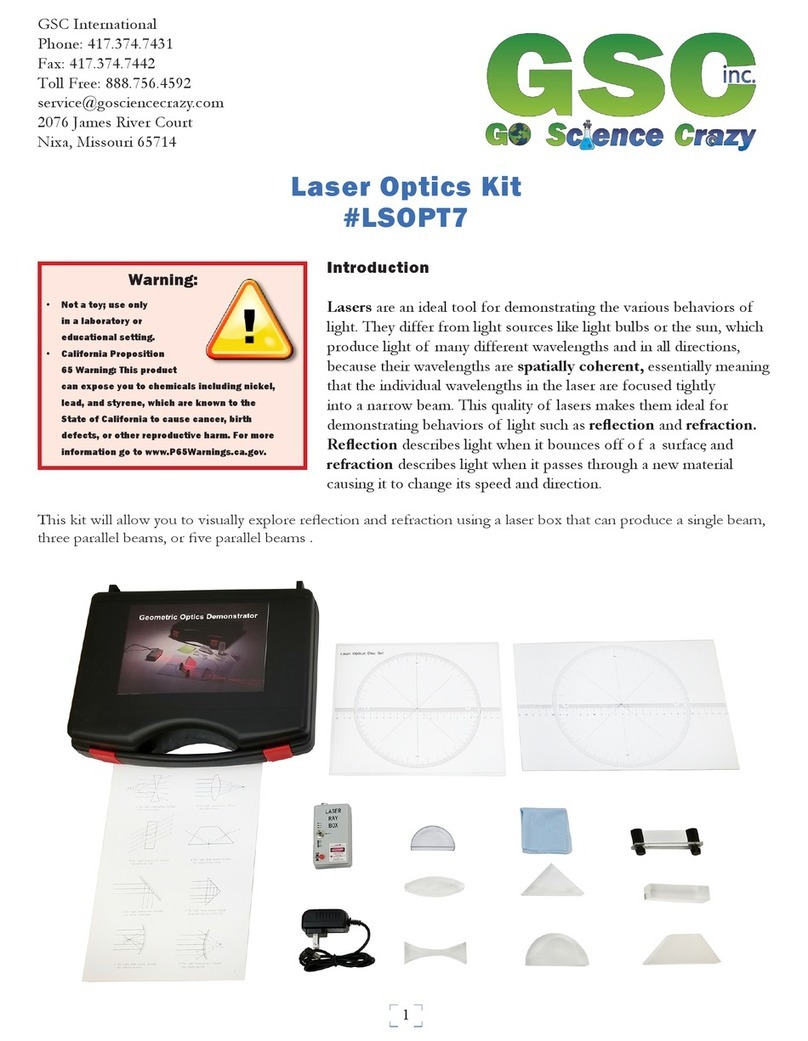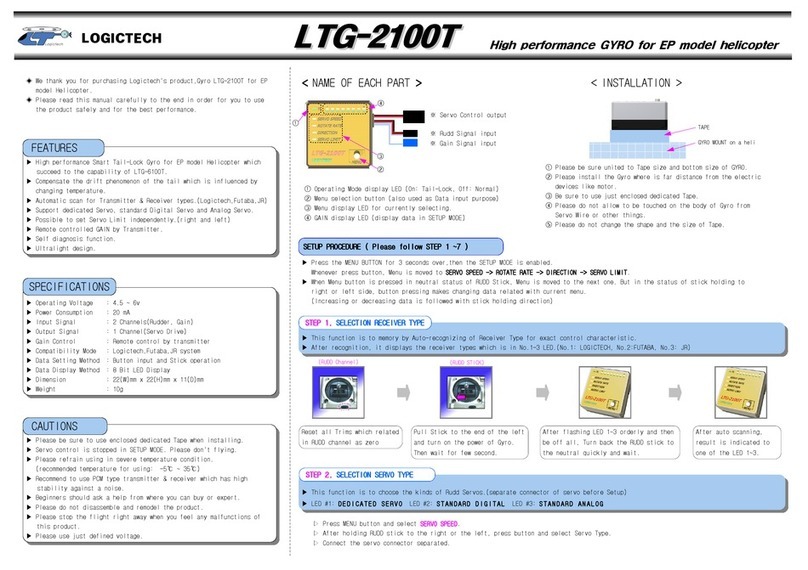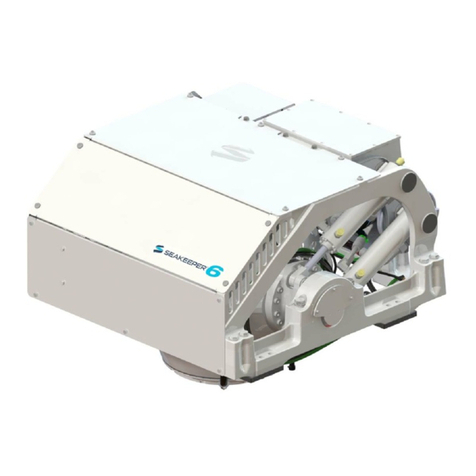Thames & Kosmos 550101 User manual

Franckh-Kosmos Verlags-GmbH & Co. KG, Pfizerstr. 5-7, 70184 Stuttgart, Germany | +49 (0) 711 2191-0 | www.kosmos.de
Thames & Kosmos, 301 Friendship St., Providence, RI, 02903, USA | 1-800-587-2872 | www.thamesandkosmos.com
EXPERIMENT MANUAL
QUICK START!
Want to get started right away
without reading the manual?
Scan the QR code below to view
online videos showing how to
assemble and use this kit.

› › › IMPORTANT INFORMATION
Dear Parents and Adult
Supervisors,
Physics is an exciting and expansive science
that is not hard to understand, especially when
you use fun models to demonstrate physics
principles in action. It can be a lot of fun to
figure out the astonishing physical phenomena
that we encounter every day and to put this
understanding to use — in a gumball machine,
no less!
This experiment kit and the working
models you can build with it introduce your
child to physics concepts including forces,
interactions, motion, and mechanical
advantage. With its hands-on models, your
child will gain basic insights into the world of
physics principles — which will help him or her
to understand and engage more deeply in the
lessons taught in school.
The gumball machine is assembled step by
step using reconfigurable parts. It will require a
little practice and patience to put it together
and to get the gumball to go exactly where you
want it to go. Your child will be particularly
happy to have your help with the parts that he
or she finds more difficult.
We wish you and your child lots of fun
experimenting, discovering, and learning!
Safety Information
››› Warning! Not suitable for children
under 3 years. Choking hazard — small
parts may be swallowed or inhaled.
Strangulation hazard — long cords may
become wrapped around the neck.
››› Keep the packaging and instructions as
they contain important information.
››› Store the experiment material and
assembled models out of the reach of
small children.
››› Clean the plastic parts before first use
and regularly in lukewarm water. Do not
clean in hot water. Dry thoroughly before
use.
››› Refer to the packaging for the
nutritional information and the
ingredients list for the gumballs.
WARNING:
CHOKING HAZARD — Small
parts. Toy contains a small ball. Not
for children under 3 yrs.

No. Description Qty.
1 Vertical tower support A 1
2 Vertical tower support B 1
3 Globe top 1
4 Globe bottom 1
5 Tip-over tube 1
6 Globe base with dispenser 1
7 Base 1
8 Leg 4
9 Globe funnel 1
10 Pulley cup 2
11 Pivot post, angled 2
12 Pivot post, straight 3
13 Tip-over tube clamp 1
14 Trampoline ring 1
15 Pulley wheel 1
16 Variable-slope track holder 1
17 Collection cup 1
18 Domino piece, beaker 2
Checklist: Find – Inspect – Check off
What’s inside your experiment kit:
Replacement gumballs: The gumball machine
uses standard small machine-sized gumballs,
which are 16 mm or 5/8 in (0.62 in) in diameter.
No. Description Qty.
19 Domino piece, erlenmeyer flask 2
20 Domino piece, florence flask 2
21 Pendulum 1
22 180-degree smooth track 1
23 Momentum trap track 1
24 Variable-slope track 1
25 Friction track 1
26 Centripetal force funnel 1
27 Pinball launcher 1
28 Domino track 1
29 Domino track post 1
30 Rubber bands for trampoline* 12
31 Piece of string for pulley cups* 1
32 Gumballs* 5.3 oz.
*Colors may vary.
550101- 0 2-2 70519
› › › KIT CONTENTS
Good to know!
If you are
missing any parts, please
contact Thames & Kosmos
customer service.
1
Gumball Machine Maker
7
9
2
10
4
12
11
8
6
14
15
17
18
19
20
21
22
23 24
28
29
30
31
32
27
25
26
16
13
1
5
3

Welcome to your Gumball Machine Maker STEM Experiment Kit! This colorful gumball
machine is not just a fun toy filled with delicious candy. It is also a set of serious scientific
equipment for hands-on physics experiments!
There are 12 different segments of track and stunt devices included in this kit. Each one of
these is an experiment. You must experiment with them to get them to work.
HERE’S HOW TO USE THIS KIT:
1Build the gumball machine tower. Follow the instructions on pages 3–4.
2Perform the experiments with each individual segment of track and
stunt device on pages 5–11. You will learn how each part works and
see what physics principles it demonstrates.
3If you would like to watch online videos with instructions and demos
for some easy track setups, scan this QR code:
4Now you are ready to try the more challenging gumball machine
setups on pages 12–20. Each of these uses multiple tracks and stunts.
See if you can get a gumball to make it all the way to the bottom.
5Test out your own track and stunt configurations too! Can you design a gumball machine
in which the gumballs make it to the bottom every single time they are dispensed?
IMPORTANT!
Your stunts will not work every time. Sometimes gumballs
will fall out of the track or stunt device. We suggest placing the
gumball machine in a tray, in the lid of a box, or on a piece of
fabric like a tablecloth to prevent the gumballs from rolling all
over the place when they fall out. Do not eat any gumballs that
fall onto the floor.
The normal variation in the weight and shape of the gumballs
will cause some gumballs to perform better in the stunts than
others. It’s physics!
If a stunt doesn’t work as you expected it to, adjust something
and try it again. You can do it!
Turn the dispenser knob clockwise to dispense a
gumball. If the knob gets stuck, turn it counter-
clockwise. This will release the gumballs and help
clear jams.
Dispense gumball
Release stuck gumball
START HERE!
2
› › › INTRODUCTION

First, assemble the gumball machine tower. All
of the experiments and setups use this tower.
HERE’S HOW
1Attach the four legs to the base. Slide them
down until they snap into place.
2Slide the two vertical tower supports
together all the way.
3Insert the tower into the base. The tabs on
the tower go into the holes in the base.
4Slide the globe base with dispenser and
knob onto the top of the tower.
› › › TOWER ASSEMBLY
Gumball Machine Maker
3
1
2 3
4

5Put the bottom and top halves of the globe
onto the globe base. Press them in securely.
6Attach the globe funnel to the top of the
globe.
7Pour some of the gumballs into the globe.
Examine the tower assembly. The gumballs
are dispensed from the globe at the top
and gravity pulls them down the tracks,
which spiral around the tower. The globe
can be rotated around on the top of the
tower so that the knob and dispenser can be
positioned above any of the four sides.
There are circular pegs on each of the four sides
of the tower. In the assembly instructions, the
pegs are referred to from the top down. For
example, this symbol means the second peg
from the top: 2. To attach tracks and other
parts to the tower, first put the peg through the
round part of the hole in the track piece, then
slide the track piece down to lock it in place in
the narrower part of the hole.
The globe funnel allows you to return gumballs
to the globe after an experiment.
Continue to the next page to start experimenting
with the different tracks and stunt devices.
4
› › › TOWER ASSEMBLY
5 6
7
Done!
1
2
3
4
5
6
7
8
9
10

› › › EXPERIMENTS
180-Degree
smooth track
WHAT’S HAPPENING
The 180-degree smooth track is the simplest
track segment. A gumball rolls from the top to
the bottom, 180 degrees around the tower. This
simple motion demonstrates many things. The
gumball has mass. Mass is the quantity of
matter in an object or a body, which is a physics
term for a physical thing. Matter is any physical
substance that occupies space. Mass can also be
thought of as the ability of a body to be heavy.
Mass should not be confused with weight
though. Weight is a measure of the force that
gravity exerts on mass.
A force is the cause of a change in a body’s
state of movement. A force can be thought of as a
push or a pull on an object. A push of the gumball
causing it to roll across the table is a force.
Gravity is also a force. It is Earth’s force of
attraction on mass. Gravity is a fascinating
thing: All mass attracts each other. The larger
the mass, the greater its force of attraction.
Earth has a huge mass: 5.9 trillion trillion
kilograms, or 13 billion trillion tons! The
gumball has a very small mass: about two
grams. Therefore, Earth pulls the gumball
toward it. This is the force of gravity!
A gumball rolls down the track because
gravity is pulling it. On Earth, the gravity at the
surface is a downward force that causes an
acceleration equal to about 9.8 meters per
second per second (m/s/s or m/s2).
To understand acceleration, we have to
understand speed. Speed is the distance traveled
by a body in a certain amount of time. Velocity is
a physics term for speed that also takes into
account the direction of motion.
If a gumball travels five inches in one
second, its speed is five inches per second, or 5
in/s — which is equal to about a quarter of a
mile per hour.
Acceleration is the measure of the change in
speed (or more accurately, velocity) over a
certain amount of time. So, what is gravity
again? Earth’s gravity causes a body to
accelerate to a speed of 9.8 meters per second
for every second that gravity acts on the body —
regardless of the mass of the body. If you drop a
gumball and it falls for three seconds, by the end
of its fall, it is moving at a speed of 29.4 meters
per second (9.8 m/s2x 3 s = 29.4 m/s).
As the gumball rolls down the track, gravity
accelerates it and it moves faster, unless it
encounters obstacles.
Amazing! This one simple segment of track
has allowed us to define all these physics terms.
Now that you have assembled the tower, let’s
conduct a series of experiments to learn how
each track segment and stunt device works. All
of these parts attach to the pegs on the sides of
the tower, and each one can be used to
demonstrate physics principles.
Experiment 1: Force and Motion
HERE’S HOW
1Attach the 180-degree smooth track to the
tower at any height. Two of the holes attach
to pegs on the same level, and the third
attaches to a peg one level down. You have
to stretch the track a little to get it to fit onto
the pegs.
2Position a gumball at the top of the track.
Have your hand ready to catch it at the end
of the track. Let it go. What do you observe?
Gumball Machine Maker
5

› › › EXPERIMENTS
Experiment 2: Momentum
HERE’S HOW
1Attach the momentum trap track to the
tower at any height. Two of the holes attach
to pegs on the same level, and the third
attaches to a peg one level down. You have
to stretch the track a little to get it to fit.
2Place a gumball on the little “speed bump”
in the middle of the track. Position another
gumball at the top of the track. Have your
other hand ready to catch the gumball at
the end of the track. Let go of the gumball at
the top of the track. What do you observe?
Momentum
trap track
“Speed bump”
WHAT’S HAPPENING
The momentum trap track demonstrates a few
more important physics principles. The momentum
trap looks like the 180-degree straight track, but
with one important difference. It has a little
“speed bump” in the middle of it. When you place a
gumball on this speed bump (or even in the little
trough in front of the bump) and release another
gumball to roll down from the top of the track,
the rolling gumball will collide with the
stationary gumball. The stationary gumball will
then be knocked into motion and continue down
the track, while the previously moving gumball
will now be stuck in the trough. To understand
what happened here in terms of physics, you
have to understand momentum and inertia.
Inertia is the tendency of a body to remain at
rest or in motion. It can also be thought of as the
amount of resistance to a change in velocity. The
more mass a body has, the more inertia it has.
Since both gumballs have the same mass, they
have the same inertia.
Momentum is the combined effect of the mass
and velocity of a body. All moving bodies have
momentum. A fundamental rule of physics says
that momentum is always conserved when two
bodies collide. When the gumballs collide, the
momentum from the moving gumball is
transferred to the stationary gumball, causing the
latter to move. The first gumball loses its
momentum and slows down. This describes a
perfect elastic collision. If the bodies were to
deform, or change shape, on impact, the result
would be different. This is an inelastic collision.
The momentum trap can also be used to show
how a gumball must have a certain amount of
momentum if it is to make it over the hill. If it has
too little momentum, it will get stuck in the trap.
6
WORK AND ENERGY
Every track and stunt also enables us to investigate
work and energy. Work is force exerted over a
distance. When you move a gumball from the
bottom of the tower up to the top with your hand,
you perform work. Moving a body requires work.
Energy is the capacity of a body to do work.
Energy is required to move a body over a distance.
Energy comes in many different forms, and it can
be converted from one form to another. This
gumball machine demonstrates two types of
energy: potential energy and kinetic energy.
Potential energy is stored energy. Kinetic
energy is the energy of motion. The gumballs at the
top of the machine have potential energy. When a
gumball starts rolling down the track, its potential
energy is converted into kinetic energy. At the
bottom of the track, it has less potential energy
than at the top. You must put energy back into it
with your hand by raising it back up to the top.

› › › EXPERIMENTS
WHAT’S HAPPENING
The variable-slope track helps you perform
experiments on the force of gravity. The track can
be set at different slopes, or degrees of steepness.
At a less-steep setting, gumballs will roll
down the track slower than at a more-steep
setting. This is because the slope prevents the full
force of gravity from pulling the gumball down
the track. The steeper the track, the more gravity
can pull the gumball along the direction of the
track. The flatter the track, the more gravity will
try to pull the gumball into the track itself, where
it cannot go. This variable-slope track is a simple
machine called an inclined plane.
At its lowest setting, gumballs actually get
caught in the track because gravity pulls them
away from the open end of the track.
Low slope
High slope
Experiment 3: Inclined plane
HERE’S HOW
1Attach the variable-slope track to the
tower. Connect it to the tower with a
straight pivot post and the variable-slope
track holder. Attach the hole of the track
holder to a peg on the same level as the
upper hole in the straight pivot post. This
results in a track with a high slope.
2Roll a gumball down the track and catch it
at the end. Observe what happens.
3Change the location of the track holder so
that its hole is on the same level as the
lower hole in the straight pivot post. This
changes the slope of the track.
4Roll a gumball down the track again.
Observe what happens this time. Increase
the slope of the track until the gumball rolls
out of the track again.
Variable-
slope track
Straight
pivot post
Variable-
slope track
holder
Experiment 4: Friction
HERE’S HOW
1Attach the friction track to the tower at any
location.
2Place a gumball at the top of the track. Have
your other hand ready to catch it at the end
of the track. Let it go. What do you observe?
Friction
track
WHAT’S HAPPENING
The friction track has raised bumps on it. These
cause the gumball to slow down as it travels
down the track. They increase the friction
between the track and the gumball. Friction is
the force resisting the motion of objects sliding
past each other. As the gumball rolls down the
track, it is releasing its potential energy as always.
It makes more noise than on a smooth track. The
increased friction is causing energy to be lost to
heat and sound. There is less energy to convert into
kinetic energy, so the gumball moves slower.
Gumball Machine Maker
7

› › › EXPERIMENTS
WHAT’S HAPPENING
The domino track offers another lesson in transfer
of momentum. When you knock over the domino
with your finger, it causes the other dominos to
fall, but it probably doesn’t push the gumball off
the post. Then, when you drop a gumball into the
top of the domino track, it knocks down the
dominos, and the last domino pushes the
gumball off the post.
In both cases, when the first domino falls over,
a chain of collisions follows, in which each domino
knocks down the next. The final domino falls over
and collides with the gumball positioned on the
post. Whether or not the final domino pushes the
gumball off the post is determined by the
momentum of the domino. The momentum from
your finger push or the first gumball falling into
the track is transferred through the dominos. Thus,
you can conclude that the falling gumball has
more momentum than your gentle finger tap.
Experiment 5: Centripetal force
HERE’S HOW
1Attach the centripetal force funnel to the
tower at any location.
2Toss a gumball into the funnel. Have your
hand ready to catch it beneath the funnel
spout. What do you observe?
Experiment 6: Collisions
HERE’S HOW
1Attach the domino track to the tower at any
location. Insert the six dominos by carefully
clicking them into the slots. Insert the small
domino track post at the end of the track. Flip
all the dominos so they are standing upright.
2Balance a gumball on the domino track post.
Have your hand ready to catch it when it falls.
Gently tap the uppermost domino over with
your finger. What do you observe?
3Reset the dominos into their upright positions.
If the gumball fell off the post, reposition it.
Now try dropping a gumball into the top of
the domino track. What happens now?
Domino track
with post
6 Dominos
Centripetal
force funnel
WHAT’S HAPPENING
The centripetal force funnel demonstrates
rotational inertia, or moment of inertia, and
centripetal force. When a gumball enters the
funnel, the shape of the funnel causes the
gumball to curve around in a circular motion. As
the gumball slows down, it circles closer and
closer to the center, and then falls into the hole.
Centripetal force is the reason the gumball
doesn’t just roll straight into the hole.
Centripetal force is a force that makes a body
follow a curved path. Like inertia, the rotational
inertia of the gumball describes its tendency to
remain in motion and resist slowing down. But
because friction and gravity work to overcome its
inertia, the gumball slowly gets closer to the hole
in the center.
8

› › › EXPERIMENTS
WHAT’S HAPPENING
When a gumball enters the cup at the top of the
pendulum at the right angle and the right speed,
it causes the pendulum to turn on its axis and the
gumball is dropped down to a lower track. When
a gumball is dropped straight down into the
pendulum cup, it often is not enough to make the
pendulum tip over on its own.
A pendulum is a weight suspended from a
pivot that can swing freely. It demonstrates
center of mass and stable equilibrium. Center of
mass is a point on a body representing the mean
(or middle) position of the mass of the body —
mass on all sides of this point balances out.
When the pendulum is stationary, it is said to be
in stable equilibrium. Equilibrium is the state of
a body at rest or in unaccelerated motion in which
the result of all forces acting on it is zero. A body is
in stable equilibrium if its center of mass is located
vertically above its base of support. If its center of
mass lies vertically above its tipping line (the edge
of the base), then it will wobble or fall over. The
slightest movement will make it tip over. But its
stability also depends on the force needed to push it
off balance.
The pendulum has been specifically designed
with a counterweight at the boom that offers just
enough inertia to keep the pendulum stable until
the gumball enters the cup and knocks it out of
stable equilibrium.
Track
without
dominos
Experiment 7: No obstacles
HERE’S HOW
1You can also use the domino track without
the dominos and post as a simple 90-degree
smooth track. Test it out!
Experiment 8: Pendulum
HERE’S HOW
1Attach the pendulum to the tower
at any location using the angled
pivot post.
2Drop a gumball into the pendulum
cup. What happens?
3Add a segment of track to the
tower in a location such that it
will deposit a gumball into the
pendulum cup. Roll a gumball
down the track into the pendulum
cup. What happens now?
Tips for the pendulum:
The pendulum might need a little push to get it
moving if the gumball doesn’t fall into it at the
right angle or the right speed.
The pendulum might not always dump the
gumball into the same spot below. This depends
on the rotational speed of the pendulum!
Pendulum
Angled
pivot post
Gumball Machine Maker
9

› › › EXPERIMENTS
Experiment 9: Springs
HERE’S HOW
1Attach the trampoline to the tower at any
location using the straight pivot post.
Stretch the rubber bands around the
trampoline ring. The notches in the ring keep
the rubber bands from slipping off. Try to
evenly space the rubber bands around the
surface of the ring. Position the trampoline
at an angle such that when a gumball falls
on it, the gumball bounces into the next
track segment.
2Drop a gumball onto the trampoline. Repeat
with the trampoline set at different angles.
Experiment 10: Projectiles
HERE’S HOW
1Attach the pinball launcher to the tower at
any location.
2Place a gumball in the launcher. Pull back
on the trigger and release. What happens?
Rubber band
color may vary.
Straight
pivot post
Rubber
bands
Trampoline
ring
Pinball
launcher
WHAT’S HAPPENING
The trampoline is a window into two more huge
realms of physics: springs and projectiles. The
rubber bands in the trampoline work like a spring.
When a moving body stretches or compresses a
spring, it converts its kinetic energy into potential
energy stored in the spring. Then, the spring
bounces back and pushes back on the body. The
amount of force exerted on a spring is
proportional to the amount, or distance, that the
spring stretches or compresses. The more
momentum a gumball has when it hits the
trampoline, the more the rubber bands will stretch.
The more the rubber bands stretch, the more force
they will have to push back on the gumball.
When the trampoline bounces the gumball into
the air, the gumball becomes a projectile. A
projectile is a body upon which only the force of
gravity is acting. The path that projectiles take as
they move through the air can be predicted based on
the speed, angle, and height at which it was
launched.
WHAT’S HAPPENING
When a gumball lands in the pinball launcher, you
can manually pull back on the trigger and release
to launch the gumball back up and out of the
track and down to another section of track.
The pinball launcher is similar to the trampoline
in that it demonstrates the principles of springs
and projectiles. In the pinball launcher, there is a
metal spring. When you pull the trigger back, the
spring compresses and stores energy. When you
release the trigger, the stored energy is released
and converts into kinetic energy, which is
transferred to the gumball, pushing it along the
track. The gumball is a projectile that glides along
the track, like a ball inside a pinball machine.
10

› › › EXPERIMENTS
WHAT’S HAPPENING
The pulley cups and wheel demonstrate a simple
machine called a pulley. This setup shows how a
downward force (the weight of a gumball) applied
to one side is transformed into an upward force of
the cup on the other side. Pulleys can change the
direction of a force, and also the amount of force
needed, to perform work. If you place two gumballs
in the second pulley cup, you probably will need
two or more gumballs to fall in the first pulley cup
before it exerts enough weight to lift up the second.
WHAT’S HAPPENING
Like the pendulum, the tip-over tube demonstrates
center of mass and stable equilibrium. When
gumballs fall into the tube, they will stay in the
tube until the center of mass extends outside of
the stable equilibrium point and the tube tips
over, dumping the gumballs into the track below.
Tips for the tip-over tube:
If the tip-over tube doesn’t tip over, try moving
the angled pivot post down one peg on the
tower, and positioning the tube higher up in the
clamp. Also, experiment with starting with
different numbers of gumballs in the tube.
Experiment 11: Pulleys
HERE’S HOW
1Attach the pulley wheel to the tower at a
relatively high location using the straight
pivot post. Tie one end of the string to the
arm of one pulley cup. Tie the other end of
the string to the arm of the second cup. Hang
the string from the pulley wheel with a cup
on either side.
2Drop a gumball into one of the cups. Drop a
gumball into the other cup. What happens?
Experiment 12: Center of mass
HERE’S HOW
1Attach the tip-over tube to the tower at any
location using the angled pivot post. If the
tube slides down in the clamp, stretch a
rubber band in an X shape over the ends of
the clamp to hold it in place. The tip-over
tube should be positioned high up in the
clamp. More of the tube should be above the
clamp than below the clamp.
2Drop gumballs into the tube one at a time.
After each drop, try to tip the tube over. As
the tube fills up, what do you notice?
Straight
pivot post
Angled pivot
post
Tube
Clamp
Pulley
cups
Pulley
wheel String
Now that you know how all the tracks and stunts work, follow the step-by-step assembly instructions on
the following pages to set up three expert-level gumball machines that use many of the parts together.
Rubber band
crossed
in X shape
Move pivot
post down
and tube up
Gumball Machine Maker
11

› › › EXPERT SETUP 1
After you have conducted the experiments on
pages 5–11, you can try out these more challenging
setups. Use what you have learned from the previous
experiments to adjust the setups until they work
properly. Can you get a gumball to make it all the way
to the bottom, landing every stunt?
HERE’S HOW
1With the rubber bands wrapped around the
trampoline ring, and the trampoline attached to the
straight pivot post (as described on page 10), attach
the trampoline with the pivot post to the tower.
Attach it to the side of the tower under the dispenser
knob, on the second and third pegs from the top;
that is, pegs 2and 3.
2Rotate the model 180 degrees so the knob is facing
backward. Attach the pendulum with the angled
pivot post to pegs 3and 4on the side of the tower
opposite the knob.
2
3
3Rotate the model
180 degrees
so the knob is
facing forward
again. Attach the
centripetal force
funnel to peg 4
on the side of the
tower under the
knob, and peg 4
on the side to the
left of that, as
shown.
180°
3
4
180°
44
12
1
2 3

› › › EXPERT SETUP 1
8
7
90°
6
6
7
90°
8
8
9
90°
4Rotate the model 90 degrees clockwise.
Attach the variable-slope track holder to
peg 6on the side of the tower under the
knob. Attach the variable-slope track with
the straight pivot post to pegs 6and 7
on the side to the right of that, as shown.
Attach the variable-slope track to its holder
by putting the peg on the holder into the
hole in the track.
5Rotate the model 90 degrees clockwise
again. Attach the momentum trap track to
pegs 8, 8, and 9on the three sides of the
tower shown in the image.
6Rotate the model 90 degrees clockwise
again. Attach the pulley wheel with the
straight pivot post to pegs 7and 8on the
side of the tower to the left of the knob, as
shown.
Tie one end of the
string to the arm of one
pulley cup. With a ruler,
measure five inches
on the string starting
at the point where you
tied the string to the
first pulley cup. Tie
the other end of the
string to the arm of the
second cup. Now, there
should be five inches of
string between the two
cups.
Hang the string from
the wheel and position
the left pulley cup
at the bottom of the
momentum trap track.
5 inches
of string 13
Gumball Machine Maker
4
5 6

› › › EXPERT SETUP 1
Done!
WHAT’S HAPPENING
In a perfect run, the machine works like this: On the first side, the gumball drops out of the dispenser
and onto the trampoline. It bounces into the centripetal force funnel, where it spirals around. It
falls through the hole and into the variable-slope track. It rolls down and into the momentum
trap. If a gumball is already in the momentum trap, the first gumball will knock the gumball that
is already there down the track and into the pulley cup. Depending on how many gumballs are in
each pulley cup, the pulley cup may move down or it may not. On the second side, the difference
is that the gumball starts in the pendulum before it falls down into a track below. Where the
gumball lands depends on the rotational speed of the pendulum. The pendulum might need a
little push, because the gumball falls straight down into it from the dispenser.
14
7
7Adjust all the tracks and stunts so that,
in your best estimation, a gumball will
travel all the way from the dispenser down
to the pulley cup. Place a gumball in the
momentum trap and in the pulley cup on the
right. The assembly is finished!
Now it’s time to test the setup!
8It’s a good idea to put the gumball machine
on a tray, in the lid of a box, or on a piece
of fabric like a tablecloth when you are
experimenting with it. The reason for this is
that it is normal for gumballs to fall off the
track or for a stunt to miss its target some
of the time. You must carefully adjust the
model to get the gumball to travel from the
top to the bottom without falling off course.
The tray, box lid, or tablecloth will help
keep the gumballs from rolling all over the
place when they fall out of the machine.
9Hold the gumball machine steady with one
hand. Turn the knob clockwise to dispense
one gumball. If the knob gets stuck, turn it
counterclockwise to release the jam. What
happens?
10 Segment by segment, make adjustments to
the model until the gumball makes it all the
way to the cup at the end.
11 Rotate the globe and dispenser to the other
side and try the second course.
12 Return the gumball to the globe each time
by taking the pulley cup and dumping it into
the globe funnel.

› › › EXPERT SETUP 2
Now that you have built the first setup, try this
setup. It is even more challenging.
HERE’S HOW
1Attach the momentum trap track to the
tower. Attach its left side to peg 1on the
side of the tower under the knob. Attach
the middle to peg 1on the next side of the
tower to the right, and its right side to peg
2on the side of the tower opposite the
knob.
2Rotate the model 180 degrees so the knob
is facing backward. Attach the 180-degree
straight track to pegs 1, 1, and 2on the
side of the tower opposite the momentum
trap track.
3Attach the pinball launcher to pegs 3
and 4on the sides under the 180-degree
straight track, as shown.
1
1
2
34
180°
112
15
Gumball Machine Maker
1
2 3

› › › EXPERT SETUP 2
4Rotate the model 180 degrees. Attach the
domino track to the tower. Attach its left
side to peg 3on the side of the tower under
the knob. Attach its right side to peg 4on
the side of the tower to the right of the knob.
4a Insert the six dominos and the domino track
post into the domino track. The flat side of
each domino should be facing the higher end
of the domino track.
4b Make sure all the dominos are standing
straight up. They will probably fall over
during assembly. Just set them back up
again before each gumball run.
5Rotate the model 90 degrees. Attach the
centripetal force funnel to the tower. Attach
its left side to peg 5and its right side to
peg 5as shown.
Post
180°
34
90°
5
5
16
4
5
4b
4a

6Attach the tip-over tube with the angled
pivot post to pegs 8and 9as shown.
Make sure the tip-over tube is held high up in
the clamp, so that a gumball coming out of
the funnel will fall into the tube.
7Hang the collection cup on the edge of the
base, under the tip-over tube.
8Adjust all the tracks and stunts so that,
in your best estimation, a gumball will
travel all the way from the dispenser down
to the collection cup. Place a gumball in
the momentum trap, one on the post in the
domino track, and two in the tip-over tube.
The assembly is finished!
Now it’s time to test the setup!
9Follow steps 8 through 11 on page 14 like
you did for the first setup.
12 When the gumball falls into the pinball
track, you have to launch it back out by
pulling the trigger back and releasing it.
After a run, return the gumball to the globe
each time by taking the collection cup and
dumping it into the globe funnel.
› › › EXPERT SETUP 2 Done!
WHAT’S HAPPENING
In a perfect run, the machine works like this:
On the first side, the gumball drops out of the
dispenser into the momentum trap track. The
gumball from the trap drops into the pinball
launcher, where you fire it back out and it falls
into the tip-over tube. On the second side, the
gumball rolls from the 180-degree smooth
track and knocks over the dominos, then flies
out of the machine because of how fast it is
moving. The dominos knock the gumball from
the domino track into the centripetal force
funnel. Then it rolls into the tip-over tube,
which tips over and empties into the cup or
the base of the machine. You might need to
tap the tip-over tube to get it to tip over.
8
9
17
Gumball Machine Maker
6 7
8

› › › EXPERT SETUP 3
Now that you have built the first two setups, try
this setup. It is the most challenging.
HERE’S HOW
1Attach the 180-degree straight track to pegs
1, 1, and 2on the sides of the tower as
shown. Pay attention to the knob location.
2Rotate the model 180 degrees so the knob is
facing forward. Attach the momentum trap
track to the tower to pegs 1, 1, and 2on
the sides of the tower as shown.
3Attach the domino track to pegs 3and
4on the sides under the momentum trap
track, as shown.
3a Insert the six dominos and the domino track
post into the domino track.
1
2
1
180°
1
2
1
3
4
18
1
2 3
3a
Table of contents
Other Thames & Kosmos Science Education Product manuals

